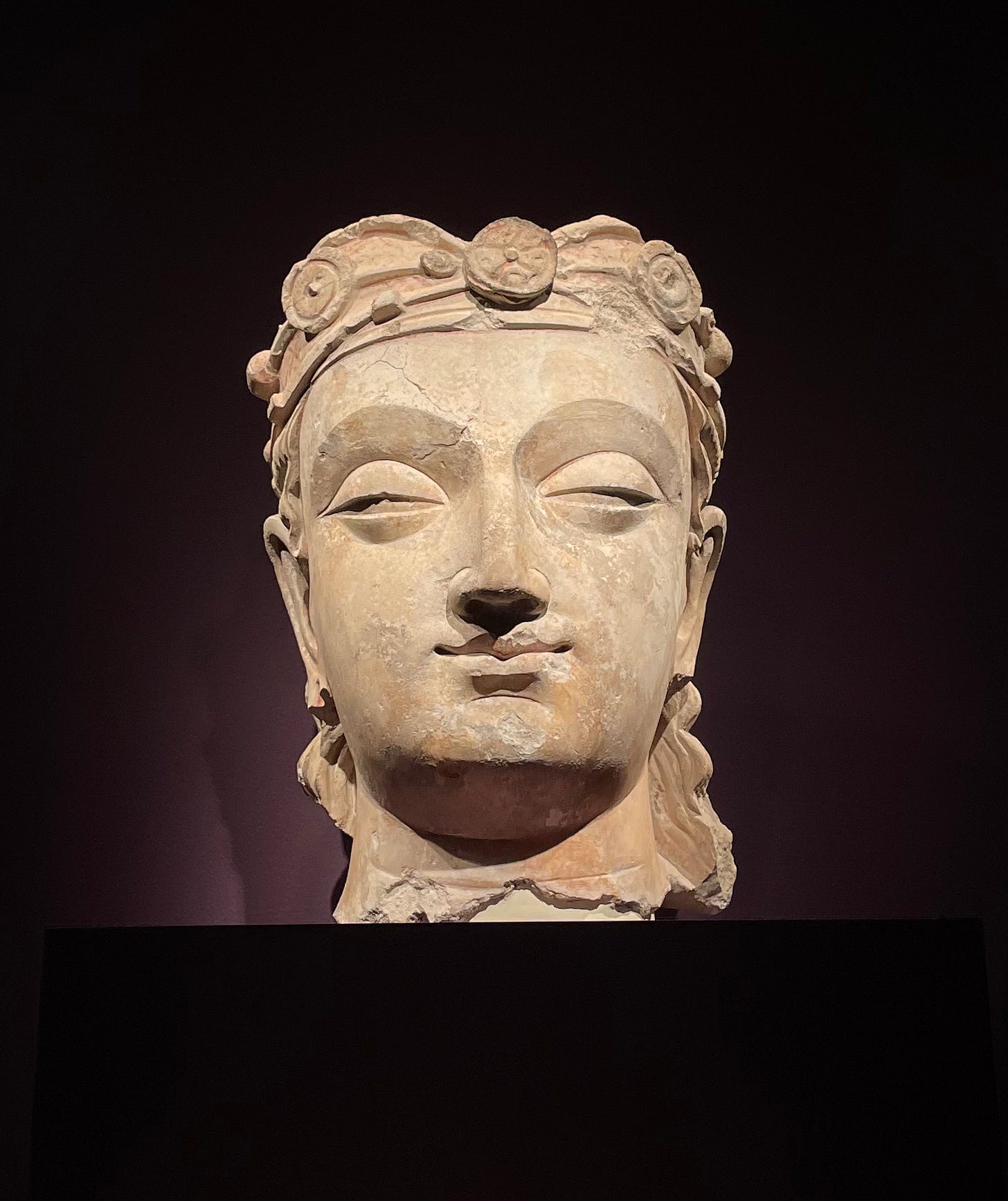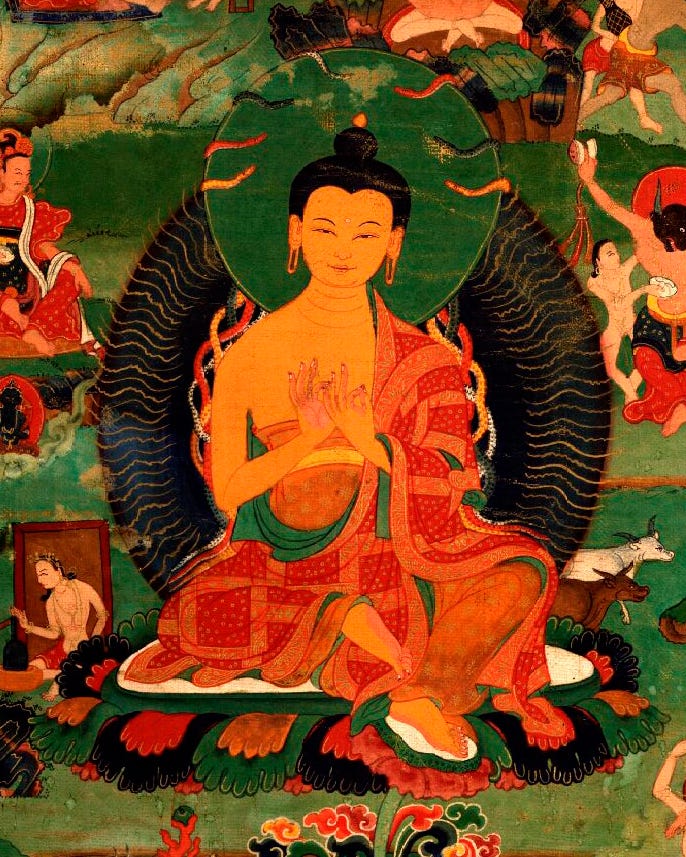How to lose yourself with Buddha and followers—Part II
Part XXXIIb of the Ancient Wisdom for Modern Readers series
[Based on How to Lose Yourself: An Ancient Guide to Letting Go with Buddha and his followers, translated by Jay L. Garfield, Maria Heim, and Robert H. Sharf. Full book series here.]
Yesterday we have taken a look at the general structure of How to Lose Yourself, a collection of newly translated Buddhist writings curated by Jay L. Garfield, Maria Heim, and Robert H. Sharf for Princeton University Press. We then examined the first of the three parts in which the book is divided, devoted to early Buddhist texts belonging to the Pali canon. Let us now turn to parts 2 and 3, focusing on the so-called Middle Way teachings and the Chan (or Zen, in Japanese) texts.
Middle Way Teachings
In the central part of the book, Jay Garfield introduces us to the teachings of the so-called Middle Way. This is the Mahayana, or “Great Vehicle” tradition, which in turn comprises two major currents: Madhyamaka (Middle Way proper) and Yogacara (Mind Only).
These developments retained some of the crucial notions of early Buddhism, especially the idea that there is no self though there are persons, but crucially—according to Garfield—shifted the understanding of the two truths: while in early Buddhism there was the surface-level truth of conventional language and the deeper truth of the enlightened, now these were treated as two different levels of reality.
What does that mean? One of the major figures in this period of Buddhism is the South Indian philosopher Nagarjuna. For him, persons exist conventionally, but are devoid of self. As Garfield summarizes: “because we cannot understand the person independently of the sense faculties, or vice versa, we must understand ourselves as dependently originated, empty, persons; but because we must accept the reality of those sense faculties and of persons, this analysis in terms of emptiness does not entail that we are nonexistent, but instead that we are conventionally real.” I will let the reader figure out exactly what the distinction is between non-existence and conventional existence. Please explain it to me, if you are so inclined.
Another major author featured in this context is the Tibetan Tsongkhapa (1357–1419). His position was interesting: he took conventional truth seriously and insisted that the target of negation was intrinsic, not actual existence. Garfield explains: “Buddhist analysis [according to Tsongkhapa] does not reveal merely apparent things to be non-existent, but instead reveals actual things to exist only conventionally.”
Again, I’m not sure I can make much sense of the distinction, because to me things that exist “only conventionally” do not, in fact, exist. While you puzzle that one over we move to the most problematic (to me) part of How to Lose Yourself: the Chan / Zen teachings.
There is no mind. Or is there?
In his introduction to the final section of the book, translator Robert Sharf summarizes the situation so far, unwittingly highlighting what I think are some of the major problems with the Buddhist view. Referring to the chariot analogy, he says that we learned that there is no essence to our being, that we are just a collection of parts that come together temporarily to interact in a complex fashion. So far so good.
But then he says: “The idea that the Buddhist self is an illusion that is created through the complex interaction of individual components is a bit like the contemporary theory, advanced by physical reductionists, that consciousness doesn’t exist apart from our brains.” Well, no, the first is nothing like the second. The scientific view is that consciousness is the result of physical processes in the brain, and such processes certainly are dynamic, transitory, and complex. But none of that makes consciousness into an illusion. Rather, consciousness is a type of phenomenal experience that likely evolved by natural selection because it allows the subject to better monitor and respond to both internal (from one’s own body) and external (outside environment) stimuli. The work of neuroscientist Antonio Damasio is particularly, ahem, enlightening in this respect.
Moreover, Sharf adds: “The early Buddhists believed that the parts of which we are composed include both material and immaterial components.” Which is, again, not the case for the scientific view. As far as we know, consciousness is made possible entirely by physical-chemical properties operating by means of a particular kind of substrate. Both the type of substrate and the type of processes matter, but none of that has anything to do with immaterial components, whatever that term actually means. (Some western philosophers, like David Chalmers, speak of a “hard” problem of consciousness, which allegedly shows dualism to be true and materialism to be wrong. I think that’s nonsense on stilts.)
Sharf continues: “followers of the Madhyamaka tradition, were dissatisfied with [the early Buddhist] picture. They argued that the individual components that work together to create the illusion of a self are, in the final analysis, just as ‘empty’ as is the self. … Those in the Mind Only school were dissatisfied with both Abhidharma [early Buddhist] reductionism and Madhyamaka deconstruction.” And it is to this latter group that we now turn.
According to the “mind only” tradition, our phenomenal experiences (perception of sounds and sights, internal feelings) are just mental representations. The world as we perceive it is analogous to the images on a mirror, where the mind is the mirror. Liberation then is a matter of learning to attend to the mirror while not being distracted by the fleeting images. That’s why the fundamental technique is that of Zen-type meditation, whereby the practitioner learns to pay attention to what is happening here and now in a non-judgmental way. Don’t identify with the images on the mirror, that is, the content of the experience, pay attention to the experiencing itself.
Following some who adopt this approach, the so-called Gradualists, meditation is like polishing the mirror, and the goal of the practice is to cultivate moral purity and cleansing the mind from its attachments. A more radical faction, known as the Suddenists, think that pursuing any goal, including the loft ones just mentioned, is still clinging onto something, thus perpetuating the problem of attachment.
One of the Suddenists, the 9th century Chan / Zen master Linji Yixuan, famously said “If you meet the Buddha, kill the Buddha,” presumably not literally, but in the sense that one needs to let go even of the very notion of a spiritual path. This is getting more than a bit weird, and to give you a taste here is a sample of a famous dialogue between a student named Threshold and a teacher named Master Verity, from The Treatise on the Cessation of Discernment. The bits in square brackets are my (rather puzzled!) comments.
Keep reading with a 7-day free trial
Subscribe to Figs in Winter: Stoicism and Beyond to keep reading this post and get 7 days of free access to the full post archives.





